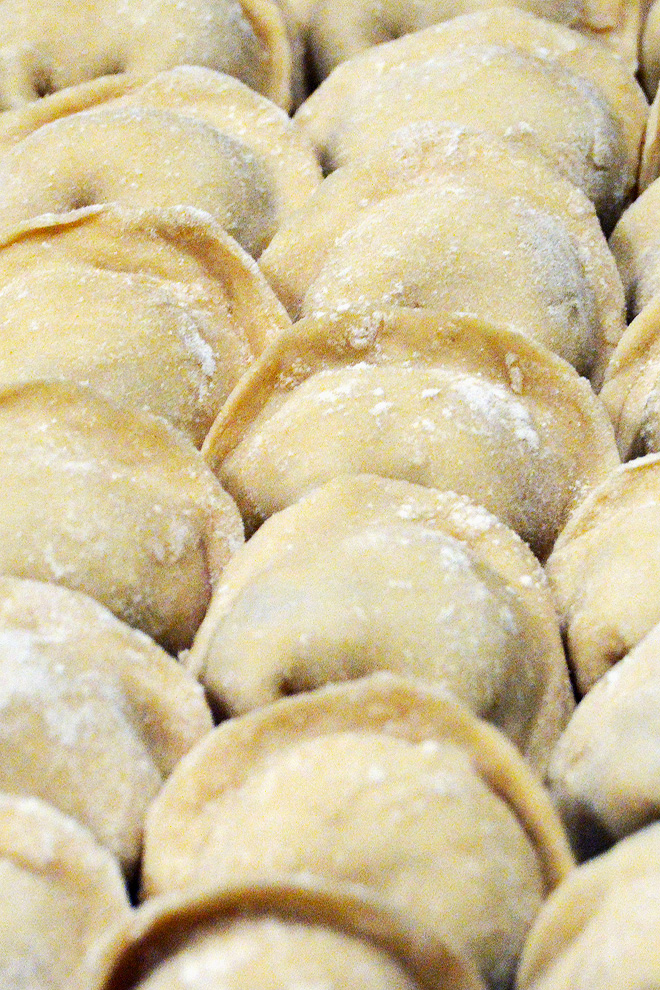Bezglutenowe Ciasto na Pierogi
Gluten-free Pierogi Dough (Vegan, Nut-free)
How to pronounce it?
BES-glue-tenoveh chia-stoh na pierre-oghee
‘Play’ to hear:

This Gluten-free Pierogi Dough will satisfy your cravings for Polish dumplings, even if grains are a no-no in your diet. In this recipe, we’re replacing wheat flour with a combination of two flours: buckwheat and potato.
For the full list of ingredients & detailed instructions, please see the recipe card at the end of this post. But before you scroll, there’s important stuff to know below.
Gluten binds everything together and lends that elasticity to the dough. That’s why we need to find a substitute that will work just as well. Potato flour is key here – it acts like glue and makes the dough more plastic. Perfect for wrapping dumplings!
Now all you have to do is choose the stuffing:
- Have a look at these pierogi filling ideas
- Or go straight to my favourite: ‘Ruskie’ Potato & Cheese Pierogi
If you would like to learn more about our Polish dumplings and how they’re made, have a look at my Pierogi guide.
Do you need any special ingredients to make this Gluten-free Pierogi Dough?
To make this Grain-free dumpling dough, you’ll need buckwheat and potato flours. These are available at large supermarkets, health stores and online.
What dishes can you make with this Gluten-free Pierogi Dough?
This Gluten-free Dough goes well with any filling, from hearty Meat, to creamy Cheese, to a sweet Blueberry.
You can also use the same dough for ‘Uszka’ (tiny dumplings served in Red Barszcz Soup).
Can you make this Gluten-free Pierogi Dough another way?
I’ve seen recipes using tapioca, corn and rice flours, but I haven’t tried them yet – therefore I cannot recommend an alternative.
For options containing gluten, try one of these recipes.
What diets is this Pierogi Dough suitable for?
As the title suggests, this is a grain-free recipe. It’s suitable for anyone who avoids gluten in their diet. It’s dairy-free as well.
Depending on the selected filling, pierogi will become suitable for vegetarians. To start, I would recommend Potato & Cheese or Sweet Cabbage stuffing.
How long can you keep this Gluten-free Pierogi Dough in the fridge?
I wouldn’t recommend refrigerating the leftover dough. It’s better to store pierogi with filling, either just blanched or fully cooked – they can be stored for up to 3 days.
Can I freeze this Gluten-free Pierogi Dough?
I wouldn’t recommend freezing just the dough on its own. But you can freeze the whole pierogi, stuffed with a filling of your choice.
To do so, find a tray or a cutting board that fits into your freezer. Grease it lightly and place cooled dumplings onto it (make sure they don’t touch each other). Place the tray in the freezer for 2 hours. After that time you can transfer frozen pierogi into a freezer-friendly bag.
When you’re ready to eat them again, thaw pierogi overnight and reheat them in boiling water. Serve with a topping of your choice or finish off on a frying pan for some extra crispness.

Gluten-free Pierogi Dough

This versatile gluten-free pierogi wrapper cooks up great and is suitable for any kind of filling; sweet or savoury.
Ingredients
- 1⅔ cups (200 g) buckwheat flour + some more for sprinkling
- ⅔ cup (100 g) potato flour
- 1 tbsp canola oil
- ½ tsp salt
- 1 cup (250 ml) boiling water
Instructions
- Mix both flours (1⅔ cups of buckwheat ⅔ cup potato flour) and salt together. Sift onto your worktop, I like to line it with a silicone mat first.
- Form a well and gradually start pouring in the boiling water, letting the flour absorb the liquid as you go. You have to observe how your flour behaves, there’s no need to add a full cup of water if the dough already forms nicely.
- Add 1 tablespoon of oil and knead the dough until it becomes elastic and soft.
- Divide the dough into a few parts. Roll out the dough thinly (roughly 0.08 inch / 2 mm), sprinkling with more buckwheat flour if it sticks too much.
- Using a rim of a glass (or a round cookie cutter) cut out the circles (approx. 3.2inch / 8cm in diameter). Place a spoonful of your chosen filling in the centre of each disc. Press the edges together, forming a dumpling.
- In a large cooking pot, bring water to a boil. Drop in a few pierogi at the time. Once they float, cook for another minute and then remove with a slotted spoon.
- From there, you can serve them straight away with some melted butter or another topping of your choice. Alternatively, melt some butter on the frying pan and fry them on both sides until lightly golden.
Notes
- I’ve adapted this recipe from a wonderful gluten-free blog Bez Okruszka (here’s the original recipe in Polish)
Nutrition Information:
Yield:
60Serving Size:
8Amount Per Serving: Calories: 25Total Fat: 0gSaturated Fat: 0gTrans Fat: 0gUnsaturated Fat: 0gCholesterol: 0mgSodium: 24mgCarbohydrates: 5gFiber: 0gSugar: 0gProtein: 1g
Polonist is reader-supported. When you buy through links on our site, we may earn a small affiliate commission. Learn more
Recipe Information
Filed under:
Alternative traditional/regional names:
Also known / Misspelt internationally as:
Tested by:
First published on:
Recipe by / Adapted from:
Story by:
Bibliography / References: